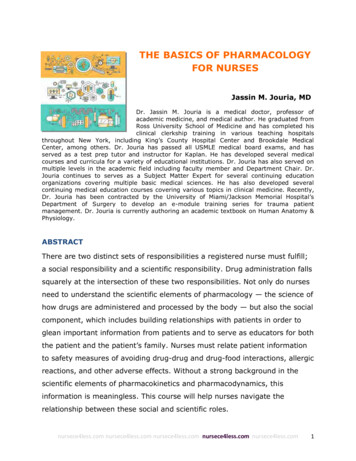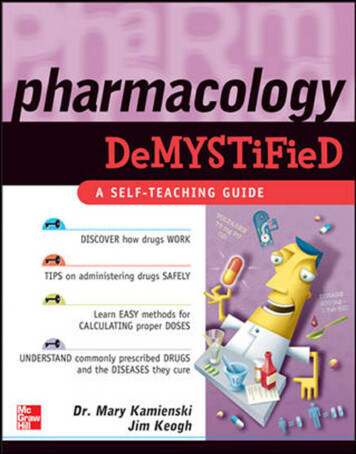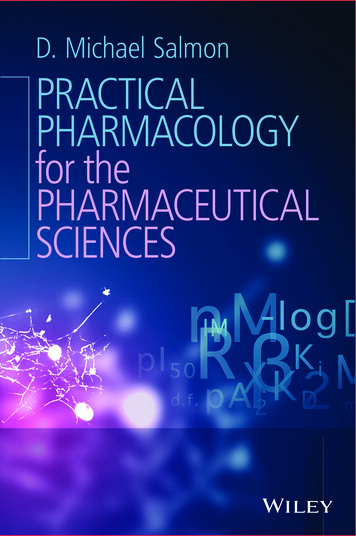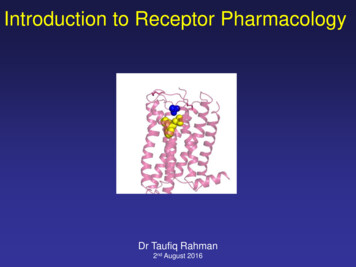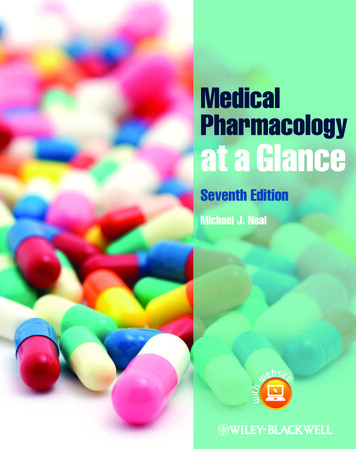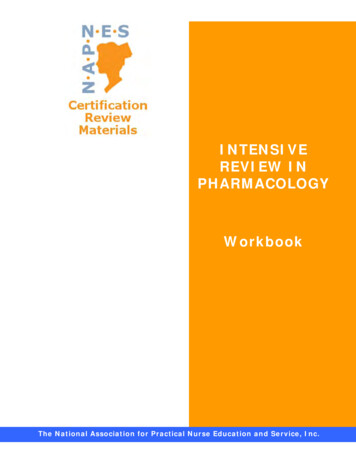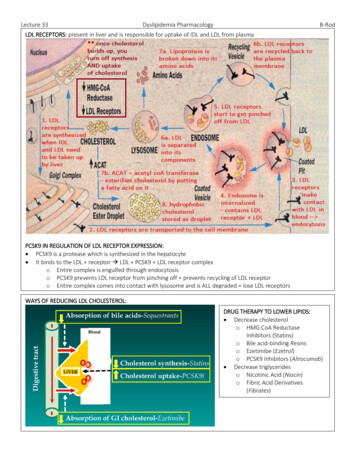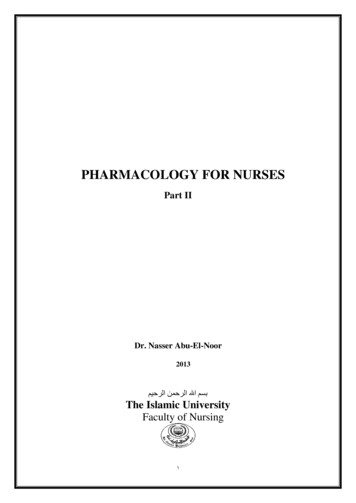
Transcription
PHARMACOLOGY FOR NURSESPart IIDr. Nasser Abu-El-Noor2013 بسم اهلل الرحمن الرحيم The Islamic UniversityFaculty of Nursing
Pharmacology For Nurses (2)Nurs 2307Prerequisites:Anatomy and physiologyTeacherNasser Abu-El-Noor, R.N., M.S.N, Ph.DPlacementSemester 4CreditsThe course is made up of 2 credit hoursCourse descriptionThe course aims to provide the nursing students the essentials ofpharmacology, with the emphasis on the application of the nursing process, drugactions, uses, routs of administration, dosages, adverse reactions, contraindications,nursing implications, and patient and family teaching about specific drugsinformation. Antidotes of some commonly known risky drugs and drug reactions aregoing to be tackled during the course period.Course objectivesOn completion of this course the student will be able to1. Accurately perform mathematical calculations when they are necessary tocalculate drug dosages2. Demonstrate awareness of various nursing responsibilities before, during,and after drug administration.3. Apply the nursing process to drug administration4. Express knowledge of various significant drugs in regard to classifications,routs, doses, and adverse effects5. Follow proper nursing implications when administering medications topatients.6. Offer the necessary teaching about drug therapy for both patients and theirfamilies7. Recognize the dangers of medications and handling them with great cautionTeaching MethodLecturesDiscussionEvaluationMidterm exam .30%Quizzes .15%Attendance . .05%Final exam . 50%
Expectations1. Students are expected to attend all lectures, unless if there is an excusedabsence. You should at least attend 75% of the lectures. If you will be absentfor more than 25% of the lectures, you will not pass the course.2. In case if an emergency happens during the midterm exams, you shouldprovide a written excuse for the professor within one week of the exam time.If you provide the excuse within one week, it will not be accepted and youwill receive a zero in the course. If your excuse will be accepted, the grade forthat exam will be added to the grade of the final exam.Course Outlines1. Cardiac drugs2. Antihypertensive drugs3. Antiarrhythmic agents4. Drugs affecting The Central Nervous system5. Centrally acting skeletal muscle relaxants6. Narcotic Analgesics & Antagonists7. Non-narcotic Analgesics & Antipyretics8. Antirheumatic & Nonsteroidal Anti-inflammatory Agents9. Anti-gout Agents10. Drugs Affecting the Autonomic Nervous system11. Adrenergic blocking (sympatholytic) Agents12. Cholinergic Blocking (Parasympatholytic) Drugs13. Drugs affecting the respiratory system14. Antihistamines15. Drugs affecting the G.I.T.16. Hormones & Hormone Antagonists17. Oral Contraceptives18. DiureticsReferences1.Loebl S., et. Al. (1991). The Nurse’s Drug Handbook, sixth edition, WileyMedical Publications, New York.2.Scherer, C. (1988). Introductory Clinical Pharmacology, third editionPhiladelphia, Lippincott3.Skidmore, L (1993). Mosby’s Nursing Drug Reference, St. Louis C.V.,Mosby.
Cardiac drugsCardiac glycoside Cardiac glycosides are the most effective drugs for treatment of C.H.F. Digitoxins are plant alkaloids. They increase myocardial contractions, which will increase blood supply to allorgans including the kidneys therefore causing diuresis, which will decreasethe edema. They are used to treat cardiac arrhythmia because they decrease heart rate. Action: They increase the force of myocardial contractions (positive inotropic). It increases the contractility of the heart muscle by minimizing the movementof Na and K ions and increasing the release of Ca ions in the myocardialcells. It decreases the heart rate due to increase in parasympathetic nervous systemand decrease in the sympathetic tone. They are primarily excreted through the kidneys. The initial dose is the larger dose (the loading or digitalizing dose), thesubsequent doses are referred to as (Maintenance doses). Results: Decrease in venous pressure. Coronary dilatation. Reduce heart size. Marked diuresis and decreasing edema. Indications:1. Congestive heart failure (C.H.F).2. Cardiac arrhythmia (atrial fibrillation, atrial flutter and sinus tachycardia). Contraindication:1. Hypersensitivity.2. Angina pectoris in absence of CHF.3. Given with caution for elderly and people who have kidney failure. Side effects:1. They are extremely toxic and may cause death.
2. There is a narrow margin of safety between the therapeutic dose and thetoxic dose.3. Could cause overdose by cumulative effects of the drug, so frequentassessment of the serum level is essential.4. May cause cardiac arrhythmia such as bradycardia (below than 60 beat/minute), ventricular fibrillation (which may lead to cardiac arrest anddeath), and Bigeminal rhythm.5. Nausea, vomiting, and diarrhea.6. Headache, malaise and muscle weakness.7. Skin rashes, blurring of vision, diplopia and white halos. Note: Patients suffering from digitalis intoxication should be admitted to theICU for continuous monitoring of ECG. Administration of digitalisshould be halted. If serum potassium is below normal, administer K salts and giveantiarrhythmic drugs as Lidocain as ordered by Dr. Drug interactions:1.Antacid (they decrease the effect of digitalis).2.Fursemide (Lasix): it increase K loss and increase the chance fordigitalis toxicity. Predisposing factors for digitalis toxicity:1. K loss (hypokalemia) which results from: diuretics, NPO, gastric suction,and poor K intake.2. Pathological conditions;a. Liver disease: they decrease metabolism and therefore increase digitalislevel.b. Kidney disease: they decrease the excretion of drug and therefore increasedigitalis levels. Nursing considerations: Check doctor’s order, medication record and bottle label accurately. Observe & monitor for evidence of bradycardia or arrhythmia. Measure intake and output accurately. Weigh the patient in daily basis. Pulse should be checked by 2 nurses.
Provide the client with food high in potassium as banana, orange. Monitor serum digoxin level. Elderly people should be assessed for early signs of toxicity. Teach patients that bradyacadia, nausea, vomiting, diarrhea, appetite loss, andvisual disturbances could be early signs of toxicity. Teach client if heart rate is less than 60/minute to hold the medication and seethe doctor. Have digoxin antidote available (digoxin immune FAB). Drugs:1. Digitoxin:crystodiginClass:cardiac glycosideUses:drug of choice for maintenance in CHF.Dose:Digitalizing dose is 0.6 mg in 4-6 hours.Maintenance: 0.05 – 0.3 mg/day.2. Digoxin:Class:Lanoxincardiac glycoside.It is the drug of choice for CHF because of:1. It has rapid onset.2. It has short duration.3. It can be administered P.O. or IV.Dose:digitalization dose 0.4 – 0.6 mg followed by 0.05 – 0.35 mg once ortwice daily.3. Digoxin Immune FAB: (Ovine)Class:digoxin antidote.Action:antibodies bind to digoxin and excreted through the kidneys.Uses:life threatening digitalis toxicity or overdose.Note: cardiac arrest can be expected if an adult ingests 10 mgor if a child ingests 4 mg.Coronary vasodilatorsAntianginal drugs Angina pectoris: is a clinical syndrome characterized by paroxysm ofpain in the anterior chest caused by insufficient coronary blood flow and/orinadequate oxygen supply to the myocardial muscle.
Causes: (1) Atherosclerosis. (2) Vasospasim.There are three groups of drugs used for treatment of angina:1.Nitrates/nitrites.2.Beta-adrenergic blocking agents.3.Calcium channel blocking agents.Nitrates/nitrites:- Nitrates/nitrites - Action: direct relaxation of blood vessels and smooth musclesvasodilatationO2 requirements.- Relaxation of smooth muscles of coronary arteriesvasodilatationcoronaryblood supply to the myocardium.- Relaxation of arteries and veinsBPworkload in theheart. Objectives of treatment:1. Treatment of anginal attack and thus relief pain.2. Prophylactic treatment to prevent or delay the occurrence of MI.3. Prolongs intervals between attacks. Indications:1. Prophylaxis and treatment of acute angina pectoris.2. Treatment of chronic angina pectoris.3. Treatment of hypertension associated with MI or CHF.4. Nitroglycerin ointment for treatment of Raynaud’s disease. Contraindications:1.Sensitivity to nitratesHypotension.2. Severe anemia.2. Hypotension.3. Head trauma.4. Cerebral hemorrhage. Side effects:1. Headache, syncope, dizziness.2. Postural hypotension, transient flushing, and palpitation.3. Topical application may lead to dermatitis.
Drug interaction: Antihypertensive agents, Beta-adrenergic blockingagents, and calcium-channel blocking agent (they may lead to additivehypotension). Dosage: there are several forms available:1. Sublingual: Cordil 5 mg PRN.2. PO: Isotard 20 – 40 mg twice a day.3. Topical: available as patches or ointment.4. Parental (IV infusion). Nursing considerations:1. Medications should be taken on an empty stomach.2. Carry sublingual tablets in a glass bottle, tightly capped.3. If anginal pain is not relieved in 5 minutes by first sublingual tablet, totake up to 2 more tablets at 5 minutes interval. If pain has not subsided 5minutes after the 3rd tablet, client should be taken to the emergency roomas this case could be an infarction (MI) and not angina.4. Take sublingual tablets 5-15 minutes prior to any situation likely to causeanginal pain such as climbing stairs.5. Take sublingual tablets while sitting to avoid postural hypotension. Isosorbide dinitrate:-Present in the forms of capsules chewable, sublingual, tablets.-Trade names: Isoral, Cordil, Isotard.-Class: coronary vasodilator.-Dosage forms: caps 20-40 mg, tabs 20-40 mg.-Uses:-Tabs for only prophylaxis of anginal pain.-Chewable, sublingual to terminate acute attack and relieve acute pain.-Esophageal spasm.- Side effects: Headache, hypotension.- Dosage:-Sublingual: acute attack 2.5-5 mg Q 2-3 hrs.-Oral caps/tabs: 5-20 mg Q 6 hrs.-Extended release tabs: 20 –80 mg Q 8-12 hrs.- Note: Isosorbide mononitrate given for patients with liver impairments.
Calcium channel blocking agents:-Action: for contraction of cardiac and smooth muscle to occur, extracellularcalcium must move into the cell through openings called calcium channels.These agents inhibit the influx of calcium through the cell membraneresulting in a depression of automatically and conduction velocity in bothsmooth and cardiac muscles leading to:1.Myocardial contractility.2. Inhibit spasm of coronary arteries3. Peripheral vasodilatation4.dilatation.peripheral resistance.S. A. node automatically and conductionheart rate. Diltazem Hcl: Cardiazem, dilatam.-Class: calcium channel blocking agent (anti-angina, antihypertensive).-Uses: vasospastic angina, essential hypertension.-Contraindications: hypotension, pulmonary congestion, and MI.-Side effects: AV block, bradycardia, CHF. Hypotension.-Dosage: 30 mg qid before meals and at bedtime. Nifedipine: Adalat- Class: calcium channel blocking agent (anti-angina, antihypertensive).- Uses: vasospastic angina, essential hypertension.- Contraindications: hypersensitivity, lactation.- Side effects: pulmonary and peripheral edema, MI, hypotension, dizziness, lightheadedness, palpitation, headache, muscle cramps.- Dosage: 10- 30 mg tid.-In hypertensive emergencies: 10-20 mg given orally or sublinguallyby puncturing the capsule and squeezing contents under the tongue.Amlodipine besylateTrade name: AmicoreClass: calcium channel blocking agent (anti-angina, antihypertensive).Use: Angina and hypertension.Dose: Initially, 2.5 to 5 mg P.O. daily. Dosage adjusted according to patient responseand tolerance. Maximum daily dose is 10 mg.
Adverse reactionsCNS: headache, fatigue, dizziness, light-headedness, paresthesia.CV: edema, flushing, palpitations.GI: nausea, abdominal pain.Musculoskeletal: muscle pain.Respiratory: dyspnea.Skin: rash, pruritus.Contraindications & cautionsContraindicated in patients hypersensitive to drug.Use cautiously in patients receiving other peripheral vasodilators, especially thosewith severe aortic stenosis, and in those with heart failure.Because drug is metabolized by the liver, use cautiously and in reduced dosage inpatients with severe hepatic disease.Nursing considerationsMonitor blood pressure frequently during initiation of therapy. Because drug-inducedvasodilation has a gradual onset, acute hypotension is rare.Notify doctor if signs of heart failure occur, such as swelling of hands and feet orshortness of breath.Teach patient to continue taking drug, even when feeling better.Grapefruit juice may increase drug level and adverse reactions. Discourage usetogether. Verapamil: IkacorClass: calcium channel blocking agent (anti-angina, antihypertensive, antiarrhythmia).- Uses:- P.O:-angina pectoris.-arrhythmia (atrial fibrillation, and flutter).-Essential hypertension.- IV: supraventricular tachycardia.- Contraindications: hypotension, cardiac shock, and MI.- Side effects: AV block, bradycardia, headache, dizziness, abdominal cramps,blurring of vision, and edema. .-Dosage: Initial 80-120 mg tid then 240-480 mg /day.
Nursing considerations for calcium channel blocking agents:1. Discuss with the patient/family the goals of therapy.2. Teach them how to take pulse and blood pressure. Hold the medication in caseof hypotension or bradycardia and consult the treating Dr.3. Instruct the client to report any untoward sings as dizziness.4. In case of postural hypotension, advise the client to change position slowly.5. Advise client to sit down immediately if fainting occurs.6. Calcium antagonists should be taken with meals toGI irritation. Beta-adrenargic blocking agents: Will be discussed later. Peripheral vasodilators: Isoxsuprine: Trade name: Vasodin. Class: peripheral vasodilator. Action: Direct relaxation of vascular smooth muscles increasingperipheral blood flow, the drug also has a cardiac stimulation anduterine relaxation effect “Alpha receptor blocking and Beta receptorstimulation. Uses:1. Symptomatic treatment of cardiovascular insufficiency.2. Buerger’s disease.3. Raynaud’s disease. Contraindications: postpartum period, arterial bleeding. Side effects: tachycardia, hypotension, chest pain, nausea, vomiting,rash, dizziness. Dosage: 10-20 mg 3-4 time daily. Papverine: Class: peripheral vasodilator. Action: direct spasmolytic effect on smooth muscle and vascularsystem, bronchial muscle, GI & urinary tract. Uses:1. Cerebral and peripheral ischemia.
2. Smooth muscle relaxant/3. Paraenteral use for: Acute MI and ngina pectoris, Pulmonary embolism,and ureteral, biliary, & GI colic. Side effects: Flushing of face, hypertension, tachycardia, constipation,dry mouth and throat, headache.Antihypertensive drugs Hypertension: is a condition in which the mean arterial blood pressure iselevated. Essential hypertension: could be mild, moderate, or sever and may lead todangerous changes in kidneys, eyes and blood vessels. Secondary hypertension: a certain disease or condition leads to elevationof blood pressure such as toxemia or pregnancy, acute kidney failure, etc. Antihypertensive agents: are initiated when diastolic blood pressure ishigher that 90mm/Hg. Treatment of hypertension includes:1. Weight reduction.3. Alcohol restriction.2. Sodium restriction.4. Stop smoking.5. Exercise.6. Behavior modification. Single drug should be considered from the following classes:1. Diuretics.2. Beta-blocking agents.3. Calcium channel blocking agents.4. Angiotesin converting enzyme inhibitors. Initial therapy is continued for one month. If there is no response,combination therapy is needed. Nursing considerations:1. Determine base line blood pressure before starting antihypertensive treatment.2. Evaluate the extent of the client’s understanding of the disease and thetherapy.3. Ascertain lifestyle changes.4. Determine client’s ability to take his BP measurement.5. Record significant changes in BP readings.6. Advise client to adhere to low sodium diet.
7. Explain the importance of adhering to treatments plan.8. Teach the patient/family how to measure intake and output.1. Angiotensin-converting enzyme inhibitors (ACE-Inhibitor): Captopril: Trade name: Capotin, inhabace. Calss: antihypertensive, inhibitor of angiotensin synthesis. Action:- Captopril is a highly specific competitive inhibitor of angiotensin Iconverting enzyme. The enzyme is responsible for the conversion ofangiotensin I to angiotensin II which decrease BP.- Reduce peripheral arterial resistance.- Decrease aldosterone secretion which works to increase level of serumpotassium. Indications:1. Hypertension.2. In combination with diuretics and digitalis in the treatment of CHF. Contraindication: Hypersensitivity, renovascular disease andpregnancy. Side effects: Skin rash, loss of taste, neutropnea, nausea, vomiting,hypotension, proteinuria, renal failure and hyperkalemia. Dosage: Tablets:- 12.5 mg 2-3 time per day.-If there is no response, after 1-2 weeks, increase doseto 25 mg 2-3 time per day. Nursing considerations:1. In case of overdose, give normal saline to restore BP.2. Should not be discontinued without Dr. order.3. Obtain baseline hematological studies, liver & renal functions tests prior tobeginning the treatment.4. Determine client’s understanding of the therapy and if he/she takes othermedications.5. Observe client closely for hypotension 3 hours after the initial dose.
6. In case of hypotension, place client in supine position and give IV salineinfusion.7. Withhold potassium sparing diuretics and consult with physician(hyperkalemia may occur).8. Take captopril 1 hour before meal or on an empty stomach.9. Report skin rash, heartburn, and chest pain to physician.10.Explain to client that he may develop loss of taste for 2-3 months, if itpersist, notify the physician.Enalapril maleateClass: ACE-inhibitorUses: HypertensionDose: Initially, 5 mg P.O. once daily; then adjusted based on response. Usual dosagerange is 10 to 40 mg daily as a single dose or two divided doses. Or, 1.25 mg I.V.infusion over 5 minutes q 6 hours.Adjust-a-dose: If patient is taking diuretics or creatinine clearance is 30 ml/minute orless, initially, 2.5 mg P.O. once daily.Side effects:CNS: headache, dizziness, fatigue, vertigo, syncope.CV: hypotension, chest pain, angina pectoris.GI: diarrhea, nausea, abdominal pain, vomiting.GU: decreased renal function (in patients with bilateral renal artery stenosis or heartfailure).Hematologic: bone marrow depression.Respiratory: dyspnea, dry, persistent, nonproductive cough.Skin: rash.Other: angioedema.InteractionsDiuretics: May excessively reduce blood pressure. Use together cautiously.Insulin, oral antidiabetics: May cause hypoglycemia, especially at start of enalapriltherapy. Monitor patient closely.Lithium: May cause lithium toxicity. Monitor lithium level.NSAIDs: May reduce antihypertensive effect. Monitor blood pressure.
Potassium-sparing diuretics, potassium supplements: May cause hyperkalemia. Avoidusing together unless hypokalemia is confirmed.Contraindications & cautionsContraindicated in patients hypersensitive to drug and in those with a history ofangioedema related to previous treatment with an ACE inhibitor.Use cautiously in patients with renal impairment or those with aortic stenosis orhypertrophic cardiomyopathy.Nursing considerationsClosely monitor blood pressure response to drug.Monitor CBC with differential counts before and during therapy.Diabetic patients, those with impaired renal function or heart failure, and thosereceiving drugs that can increase potassium level may develop hyperkalemia. Monitorpotassium intake and potassium level.Instruct patient to report breathing difficulty or swelling of face, eyes, lips, or tongue.Swelling of the face and throat (including swelling of the larynx) may occur,especially after first dose.Advise patient to report signs of infection, such as fever and sore throat.Inform patient that light-headedness can occur, especially during first few days oftherapy. Tell him to rise slowly to minimize this effect and to notify doctor ifsymptoms develop. If he faints, he should stop taking drug and call prescriberimmediately.Tell patient to use caution in hot weather and during exercise. Inadequate fluid intake,vomiting, diarrhea, and excessive perspiration can lead to light-headedness andfainting.Tell woman of childbearing age to notify doctor if pregnancy occurs. Drug will needto be stopped.2. Beta-adrenargic blocking agents:-Action: it combines with beta-adrenargic receptors to block the response tosympathetic nerve impulses, circulating catecholamines or adrenargic drugs.-β-adrenergic receptors have been classified as beta 1 (in the cardiac muscle)and beta 2 (in the bronchi and blood vessels).-Blocking of β1 receptorscardiac outputHR, myocardial contractility andBP.
Blocking of β2 receptors-airway resistance (bronchospasm) , andvasoconstriction.These drugs could be selective (working on one receptor such as β1 selective-drugs (Atenolol) or it could be nonselective (such as Propranolol)Uses:1. hypertension,2. Anginal pectoris.3. Cardiac arrhythmias.4. Myocardial infarction.5. Prophylaxis of migrin.Contraindications:Bradycardia, C.H.F., cardiogenic shock, diabetes, thyrotoxicosis,chronic bronchitis, asthma, bronchospasm, emphysema.Side effects:Bradycardia, C.H.F., hypotension, cold extremities (due to peripheralvasoconstriction), edema, dyspnia, shortness of breath, nausea,vomiting, hepatomegaly and bronchospasm.Treating overdose:1.Inducing vomiting, gastric lavage.2.Artificial respiration.3.Give atropine sulfate 0.6 mg (up to 3 mg) and glycogan for the treatment ofbradycardia.4.Treat hypoglycemia and hypokalemia.5.I.V fluids.6.Adrenaline or dopamine to increase Blood pressure.Nursing considerations:1. Instruct patient/family to take blood pressure and pulse.2. Provide written instructions as when to call physician (e.g. HR below 50beat/min).3. Consult the physician before interrupting the therapy.4. Some drugs lead to blurring of vision, so that tell patients not to engage inactivities need mental alertness.5. Instruct patient to dress warmly during cold weather.6. Diabetic patient should be very careful about symptoms of hypoglycemia.7. Report any asthma-like symptoms.
Atenolol:Trade name: Normatin.Classification: Beta-adrenergic blocking agentClassification: beta 1 –adrenoreceptr blocking drug which is a cardioselective.Uses: Hypertensionangina pectoris.Dosage:Tablets: 50 mg or 100 mg dailyInitial dose is 50 mg, if there is no response, increase dose to 100 mg daily.IV in case of acute MI: give 5 mg over 5 minutes, and if there is noresponse, give another 5 mg after 10 minutes.Specific nursing considerations:3. For IV use, the drug may be diluted in sodium chloride, dextrose, ondextrose saline.Valolol: Trade name: Corgard Class: Beta-adrenergic blocking agent. Action: manifests both beta 1 and beta 2 adrenergic blocking. Uses: hypertension, angina pectoris. Dose: 40-80 mg daily.Propranolol hydrochlorideTrade name: Inderal, DeralinClassification: beta-adrenergic blacking agent, antiarryhthmic.Action: manifests both beta1 and beta 2 adrenergic blocking activity.Indication:1. Angina pectoris.2. Hypertension.3. Cardiac arrhytmias.4. Prophylaxis of migrin.5. Prophylaxis of MI.6. PheochromocytomaAdditional side effects: psoriasis-like eruptions.Dosage:Tablets: initial dose of 40 mg bid, then 120-240 mg in 2-3 divided doses.
Temolol maleate:Trade name: Blocadren, Timpotic.Classification: Ophthalmic agent, beta-adrenergic agent.Action: both beta1 and beta 2 receptors blocking activity.Uses:Tablets: for hypertension.Ophthalmic solution: chronic open angle glaucoma.3. Centrally acting agents:Used for treatment of chronic hypertension, since it affects CNS.Clondine Hydrochloride:-Trade name:- (Catapres)- Classification:-Antihypertensive, centrally antiadrenergic agent.- Action:- stimulates alpha-adrenergic receptors of CNSsympathetic vasomotor centers &nerve impulsesnhibition ofHR & BP.-Uses:- treatment of mild to moderate hypertension.-Side effects:- Drowsiness, headache, malaise, dry mouth, bradycardia, andconstipation.- N.B:- If colonidine is D.C abruptly, rebound hypertension may occur.- -Dosage:- Initially 0.1 mg bid ,then increased to 0.1 - 0.2 mg daily until desiredresponse is obtained.Methyldopa :-Trade name:-(Aldomin)-Classification:- Antihypertensive, centrally acting antiadrenergic agent.-Action:- The active metabolite alphamethylenorepinephrin lowers BPby stimulating central inhibitory alpha-adrenergic receptors.-Uses:- Hypertension & hypertension crises (parenteral).-Contraindications:1. Hypersensitivity,2. Active hepatic diseases.3. Pregnancy.4. Pheochromocytoma.
-Side effects:- Headache, dizziness, general weakness, depression and sedation.- Bradycardia, orthostatic hypotension.- Dry mouth, nausea, vomiting, sore (black) tongue.- Jaundice, liver disorders.-Hemolytic anemia, & leukopenea.-Male impotence.-Dosage:- Tabs. :- initially 250 mg bid or tid.-Nursing considerations:1. Avoid activities that need mental awareness such as driving.2. Note any evidence of jaundice and do liver function test onintervals.3. Advise pt. to rise from the bed slowly.4. Instruct pt. about reportable Signs & Symptoms5. Explain to pt. that urine rarely may be turn into dark / blue color.6.Advise client to carry a card detailing current medication regimensalways.4. Agents that act directly on vascular smooth muscles:--Hydralazine hydrochloride:-Trade name:- ( Apresoline )-Classification:- Antihypertensive, direct action on vascular smoothmuscles.-Action:- directly affect smooth musclescardiac output and finallyvasodilation,blood flow to the brain and kidneys.- Uses:- used with combination therapy to treat yhpertension.Given parenterally in hypertension emergencies.- Contraindications:- Angina pectoris.- Rheumatic heart disease.-Chronic glomerulonephritis.-Systemic lupupus erthrmatosis (S.L.E.)- Side effects:-
-Orthostatic hypotension, tachycardia, nausea, vomiting.-Headache, dizziness, constipation and male impotence.-Dosage:-Tabs. : initially 10 mg qid for 2-4 days, then 25 mg bid-I.V, I.M :-50 mg (IV slowly) repeated as necessary. ( maydecrease Bp in 5 minutes.)*** Antiarrhythmic agents **Cardiac arrhythmias:- altered patterns of contraction or markedincreased or decreased HR reducing the ability of the heart topump blood.Examples:Premature ventricular beats, atrial flutter, atrial fibrillation, ventricularfibrillation----N.B:- The effective treatment of arrhythmias depends on:1) Accurate diagnosis.2) Changing the causative factor.3) Appropriate selection of an antiarrhythmic drugs.Amiodarone hydrochloride:Trade name:- ( Procor)Classification:- AntiarrhythmicAction:- increases the duration of the myocardial cell actionpotential as well as alpha & beta antiadrenergic effect.Indications:- Should be reserved for life threatening ventricular arrhythmiaswhich don’t respond to other therapy.Contraindications:- Sensitivity.-Sinus bradycardia-AV block-Thyroid dysfunction
Side effects:-Bradycardia, CHF, Fatigue, tremors.-Visual disturbances, photophobia, dry eyes.-Hemolytic or aplastic anemia.-Hepatotoxicity.Dose:- Tabs 200 mg.-Maintenance dose: 200-400 mg daily.-IV infusion: 5 mg/kg over 20-120 minutes.2- Lidocaine Hydrochloride:Trade name: xylocaine – EsracainCalss: antiarrhrythmic.Action: shortens the refractory period & suppresses the automatically of ectopicfoci without affecting conduction of impulses through cardiac tissue.Indications: acute ventricular arrhythmias as which follow MI or ty-Heart block.Side effects: hypotension, bradycardia, dyspnea, dizziness .Dosage: available in ampules of a concentration of 1% (100mg), 2% (200mg)Loading dose : IV. Bolus 50-100 mg at rate of 25-50 mg\minInfusion : 20-50 mg\kg at a rate of 1-4 mg\m.Nursing considerations:1. Don’t add lidocain to blood transfusion assembly.2. Make certain that vials state “for cardiac arrhythmias”.3. Use 5% dextrose solution to prepare drug (stable for 24 hours).4. Assess for history of hypersensitivity.5. Use electronic infusion device to regulate the infusion of the drug.6. Obtain B.P., Pulse, Resp. rate to use as baseline data to evaluate response totreatment.7. Drug should be given in a monitored environment.8. Assess B.P. frequently during administration.
9. Assess for respiratory depression.10. If adverse reactions occur, discontinue infusion & prepare for emergencymanagement.3. PhenytoinTrade name: DilantinClass: anticonvulsant , antiarrhythmic.Action: acts in the motor cortex of the brain to reduce the spread of electricaldischarges from the rapidly firing epileptic foci in this area. Also activity ofcenters in the brain stem responsible for the tonic phase of grand mal seizures.Uses:Chronic epilepsy.Premature ventricular nsitivity.Side effects:Drowsiness, ataxia, dizziness, measles-like rash, gingival hyperplasia,Hirsutism (excessive hair growth) , hypoglycemia.N.B : - rapid I.V. administrationHypotension & arrhythmia.Dose for arrhythmias:Tabs 200-400 mg daily.I.V. 100 mg q 5 minutes up to a maximum of 1g.Nursing Considerations:1- I.V. phenytoin may forms precipitate, so flush tubing by saline (notdextrose) before & after administration.2- Assess for hypersensitivity.3- If a pregnant woman takes this drug, tell her not to breast-feed her baby.4- Obtain liver & kidney function studies.5- Monitor serum drug levels on a routine basis.6- During I.V. therapy, monitor B.P. for signs of hypotension .7- Take e food to minimize GI upset.8- If the patient is diabetic, monitor for signs of hypoglycemia.9- Oral hygiene to minimize bleeding from the gum.
10-Report any excessive growth of hair.4. Procainamide:Trade name: procanClassification : antiarrhythmicAction: produce a direct cardiac e
Pharmacology For Nurses (2) Nurs 2307 Prerequisites: Anatomy and physiology Teacher Nasser Abu-El-Noor, R.N., M.S.N, Ph.D Placement Semester 4 Credits The course is made up
